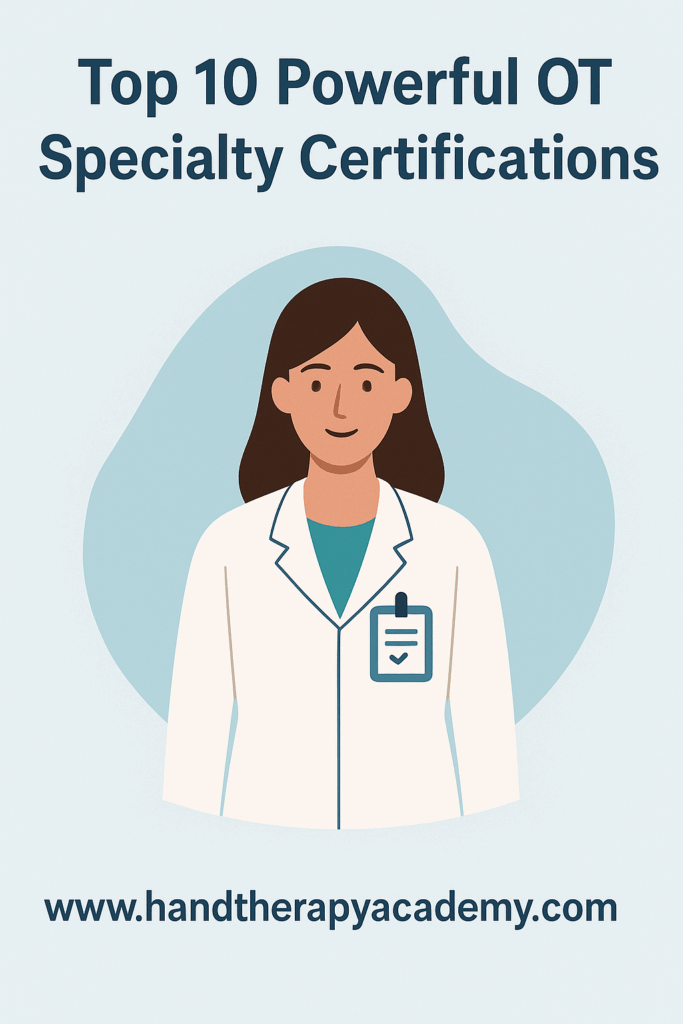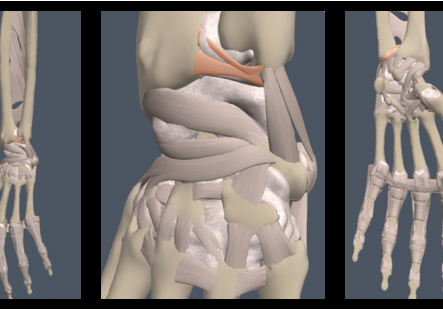Introduction to OT Specialty Certifications
Occupational therapy (OT) continues to expand into dynamic new fields, and with that growth comes the need for specialization. Whether you’re a seasoned therapist or just starting out, pursuing OT 专业认证 can significantly boost your expertise and job opportunities.
As healthcare becomes more complex in 2025, employers are increasingly valuing therapists who go the extra mile by obtaining certifications in focused areas. From pediatrics to physical rehabilitation, these credentials can be a game-changer for your professional development and impact on patient care.

Benefits of Earning a Specialty Certification in OT
Let’s explore why thousands of therapists are adding OT certifications to their resume:
- Advanced Expertise: You’ll gain deep knowledge in a niche area, improving your ability to treat complex conditions.
- Career Mobility: Certified OTs often access leadership roles, niche job markets, and private practice opportunities.
- Patient Confidence: Certifications can signal higher competence, earning trust from patients and interdisciplinary teams.
- Financial Incentives: Many certified OTs report higher salaries and better job offers.
- Professional Recognition: Stand out in your field and contribute to research, policy, and teaching.
Overview of Certification Bodies for OTs
Several authoritative bodies oversee OT specialty certifications:
- American Occupational Therapy Association (AOTA): Offers board certifications in areas like Pediatrics, Gerontology, Mental Health, and more.
- National Board for Certification in Occupational Therapy (NBCOT): Primary credentialing board for OTs in the U.S.
- Rehabilitation Engineering and Assistive Technology Society of North America (RESNA): Oversees ATP certification.
- Academy of Certified Hand Therapists (ACHT): Administers the respected CHT credential.
Top 10 OT Specialty Certifications in 2025
Let’s dive into the top 10 OT specialty certifications that are shaping the future of occupational therapy.
1. Board Certification in Pediatrics (BCP)
This certification helps OTs sharpen their expertise in treating infants, children, and teens. It covers developmental delays, sensory processing disorders, and school-based interventions.
- 合格: 3 years of OT experience with at least 5,000 hours in pediatrics.
- Maintenance: Renewal every 5 years with continuing education.
2. Board Certification in Gerontology (BCG)
Perfect for therapists working with aging adults, the BCG emphasizes fall prevention, dementia care, and aging-in-place strategies.
- Ideal Candidates: OTs in hospitals, rehab centers, or home health.
- Core Competencies: Cognitive rehab, ADL training, mobility support.
3. Certified Hand Therapist (CHT)
This joint credential for OTs and PTs focuses on treating upper limb injuries and post-surgical rehabilitation.
- 要求: 4,000 hours of hand therapy experience + passing a rigorous exam.
4. Board Certification in Mental Health (BCMH)
In high demand, this certification covers therapeutic approaches for individuals with mental illness, trauma, and behavioral challenges.
- Practice Areas: Schools, inpatient psychiatry, community clinics.
5. Board Certification in Physical Rehabilitation (BCPR)
Focuses on clients with neurological and orthopedic challenges such as strokes, spinal cord injuries, and amputations.
- Core Knowledge: Neuroplasticity, assistive devices, functional training.
6. Certified Low Vision Therapist (CLVT)
Geared toward therapists helping clients with visual impairments maximize their independence using adaptive tools and strategies.
- Cross-training: Often involves collaboration with optometrists and ophthalmologists.
7. Assistive Technology Professional (ATP)
Ideal for tech-savvy OTs, ATP certification emphasizes using digital tools and devices to support clients with disabilities.
- Key Skills: Device evaluation, system customization, ethical tech integration.
8. Certified Autism Specialist (CAS)
This certification supports therapists working with individuals on the autism spectrum across all age groups.
- 重点领域: Sensory modulation, social skills training, behavioral interventions.
9. Lymphedema Therapy Certification
Helps OTs manage swelling disorders, especially after cancer treatments like mastectomies.
- Treatment Techniques: Manual lymphatic drainage, compression, skincare.
10. Neuro-Developmental Treatment Certification (NDT)
Specialized in neurological disorders, NDT is common in both pediatric and adult rehab settings.
- Approach: Holistic, hands-on, and focused on restoring function through movement.
Choosing the Right OT Specialty Certification
With so many compelling certifications available, it’s essential to strategically select the one that aligns with your long-term goals and passions. Here’s how to narrow it down:
1. Self-Assessment
- What populations do you love working with?
- Are you more clinical, research-focused, or technology-driven?
- Do you enjoy hospital settings, schools, or home health?
2. Market Demand
Research job postings in your region. Certifications in mental health, geriatrics, and 手部治疗 are often in high demand due to aging populations and post-acute care trends.
3. Career Goals
If your aim is to specialize, open a private practice, or move into teaching, a certification may be a critical step. For tech-forward roles, consider ATP. For leadership, look into BCP or BCG.
4. Financial Investment
Some certifications are more costly or time-consuming than others. Weigh the ROI—will this certification yield salary increases, better positions, or personal satisfaction?
Process of Getting Certified: Step-by-Step
Whether you’re applying for your first or third specialty certification, the journey typically follows these steps:
1. Meet Eligibility Requirements
- Most require at least 3 years of experience 和 5,000+ hours in the specialty area.
- You must hold a current and active OT license.
2. Submit Application
- Applications typically involve case study submissions, professional references, and documentation of clinical hours.
- Expect to pay an application fee ranging from $350–$650.
3. Prepare for Exams (if applicable)
- Use official study guides, peer groups, or continuing education units (CEUs) for preparation.
- Some certifications (like CHT) require a standardized exam, while others (like AOTA board certifications) use portfolio review.
4. Certification Awarded
- Once approved, you receive your official designation and listing in a national database.
- This can boost your visibility to employers and clients.
5. Maintain & Renew
- Most certifications are valid for 5 years.
- You must complete continuing education and sometimes re-submit a portfolio or re-test.
Career Opportunities After Certification
With certification in hand, doors open in numerous directions:
| Setting | Roles |
| Hospitals | Senior therapist, Rehab specialist |
| Schools | Autism specialist, Program coordinator |
| Clinics | Low vision or hand therapy lead |
| Academia | OT instructor, research fellow |
| Private Practice | Independent consultant, NDT practitioner |
In terms of salary, many certified therapists report an annual increase of $5,000–$15,000, depending on the setting and region.
Common Myths About OT Specialty Certifications
Let’s debunk a few myths that might be holding you back:
- “They’re only for new grads.” – False! Many mid-career and senior therapists pursue certifications to pivot or specialize.
- “Too expensive and time-consuming.” – The return on investment (ROI) in knowledge, credibility, and pay often justifies the cost.
- “You need to be a genius.” – Not true. These certifications are built on your real-world clinical experience.
- “It won’t help my career.” – On the contrary, many therapists use certifications to transition into leadership or niche roles.
FAQs About OT Specialty Certifications
1. Do I need a specialty certification to practice OT?
No. Licensure is the legal requirement. Certifications are voluntary but highly beneficial for specialization and advancement.
2. How long does it take to earn a certification?
Most therapists spend 3–6 months preparing, depending on the certification and their experience level.
3. Can I hold multiple certifications?
Absolutely! Many therapists hold two or more certifications—like CHT and ATP—to diversify their practice.
4. What happens if I let my certification lapse?
You may need to reapply or retest, depending on the certifying body. Some allow grace periods with penalties.
5. Are there online courses to help me prepare?
Yes! Hand Therapy Academy offers different options for your career.
6. Will certification make a big difference in my resume?
Yes. It distinguishes you from other candidates and shows commitment to lifelong learning and clinical excellence.
Conclusion: Future of Specialized Occupational Therapy
The field of occupational therapy is growing more nuanced and multifaceted every year. OT 专业认证 empower professionals to stay ahead, serve clients better, and enjoy fulfilling careers.
As healthcare continues to demand specialized care, certified OTs will lead the way with innovation, compassion, and credibility. Whether you’re passionate about neuro rehab, pediatrics, or assistive technology, there’s a certification out there to match your calling.So don’t wait—invest in your growth, credibility, and impact today!
更多阅读内容
DRUJ 不稳定和手部治疗干预
DRUJ 不稳定和手部治疗干预 远端桡骨尺骨关节 (DRUJ) 是由远端桡骨和尺骨组成的关节,由称为 TFC 的韧带结构固定在一起。 DRUJ 不稳定本质上可以是急性的或慢性的。急性损伤通常通过将患者置于……中来解决。
阅读更多中风后拉伸以缓解痉挛
快速审核人:Mikayla Murphy Kerr, L.、Jewell, VD 和 Jensen, L. (2020)。针对中风后痉挛、手功能和功能任务的拉伸和夹板干预:系统评价。美国职业治疗杂志,74, 7405205050。https://doi.org/10.5014/ajot.2020.029454 瘦身这项研究重点关注拉伸上肢以减少痉挛、增加……的好处。
阅读更多注册即可直接将更新发送到您的收件箱!
注册我们,我们将定期向您发送有关手部治疗的所有内容的博客文章、每次上传新视频和教程时的通知,以及讲义、协议和其他有用信息。





